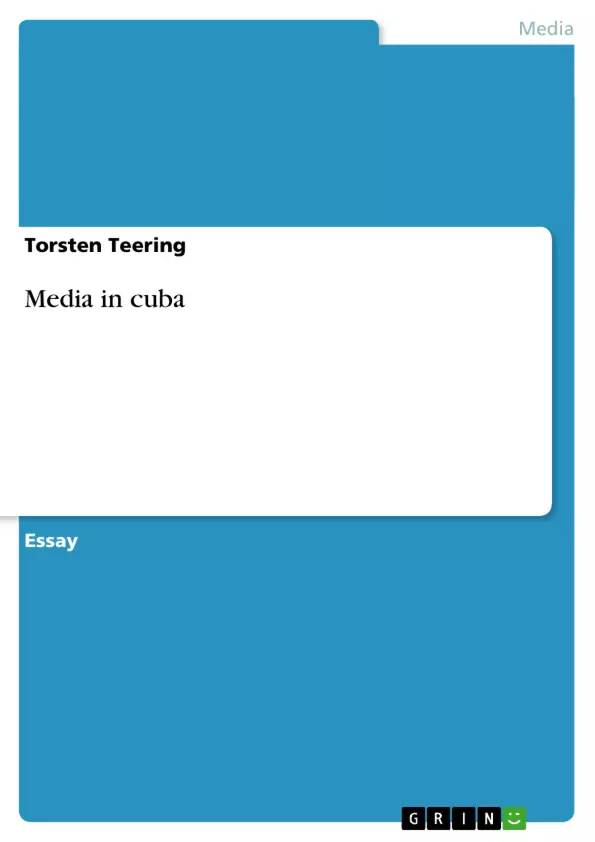[...] The essay will further take a brief look at the less important television market, especially at CubaVision Internacional, broadcasting via satellite around the world. After that, it will analyse independent journalism in Cuba; providing further information about the role of the media, the essay will explain why the situation of independent journalists is one of fear and threats. The final part of the essay will evaluate the propaganda tools of the ‘enemy’, the United States, which are Radio and TV Marti. It will analyse their effectiveness, their history and the role for them in Cuba.[...]
Inhaltsverzeichnis (Table of Contents)
- Introduction
- Cuba now
- The role of the media in Cuba
- The Press in Cuba
- Granma
- Juventud Rebelde
- Radio in Cuba
- TV in Cuba
- Independent Journalism
- Media from outside
- Radio Marti
- TV Marti
Zielsetzung und Themenschwerpunkte (Objectives and Key Themes)
This essay provides an in-depth analysis of the media landscape in Cuba, focusing on its unique characteristics within a communist context. It examines how the media operates as a tool for state propaganda, influenced by historical factors like the end of Soviet aid and the "Special Period" economic crisis. The essay investigates the relationship between Marxist-Leninist ideology and the media's role in shaping public opinion.
- The influence of Marxist-Leninist ideology on the Cuban media system.
- The historical impact of the end of Soviet aid and the "Special Period" on the Cuban media landscape.
- The role of the media in promoting state propaganda and shaping public opinion.
- The limitations and challenges faced by independent journalism in Cuba.
- The effectiveness of US propaganda tools, such as Radio and TV Marti, in influencing Cuban audiences.
Zusammenfassung der Kapitel (Chapter Summaries)
- Introduction: This chapter introduces the essay's focus on the media landscape in Cuba, outlining the historical and political context, and setting the stage for the subsequent analysis. It briefly discusses the economic and social situation in Cuba following the end of Soviet aid and the fall of communism.
- Cuba now: This chapter provides an overview of Cuba's current state, including its geography, population, literacy rate, and the leadership of Fidel Castro. It describes the economic crisis following the withdrawal of Soviet subsidiaries and the "Special Period," detailing the impact on the Cuban economy and people's lives.
- The role of the media in Cuba: This chapter delves into the theoretical framework of the media in a communist country according to Lenin and Marx. It explores the concept of the media as a propaganda tool and its role in shaping public opinion and supporting state ideology. The chapter highlights the Cuban government's control over the press, radio, and television.
- The Press in Cuba: This chapter examines the specific case of the press in Cuba, focusing on the prominent newspapers, Granma and Juventud Rebelde. It discusses the decline in newspaper circulation and the challenges faced by the media during the economic crisis.
Schlüsselwörter (Keywords)
This essay examines the media landscape in Cuba, focusing on key terms like state propaganda, Marxist-Leninist ideology, "Special Period," independent journalism, and US propaganda tools like Radio and TV Marti. It explores the relationship between the Cuban government's control of information and the media's role in shaping public opinion within a communist context.
- Quote paper
- Torsten Teering (Author), 2003, Media in cuba, Munich, GRIN Verlag, https://www.grin.com/document/17384



